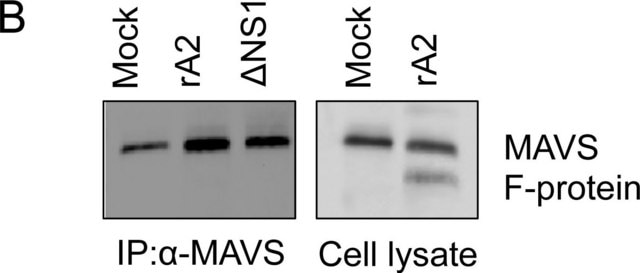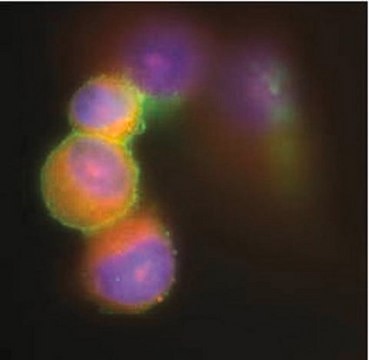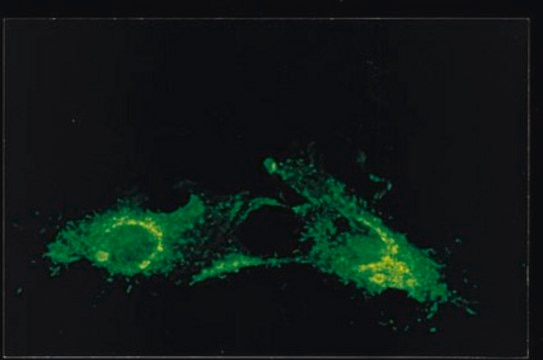MAB858-1
Anti-RSV Antibody, fusion protein, all type A, B strains, clone 133-1H
ascites fluid, clone 133-1H, from mouse
Synonym(s):
RSV
Sign Into View Organizational & Contract Pricing
All Photos(1)
About This Item
UNSPSC Code:
12352203
eCl@ss:
32160702
NACRES:
NA.41
Recommended Products
biological source
mouse
Quality Level
antibody form
ascites fluid
antibody product type
primary antibodies
clone
133-1H, monoclonal
species reactivity
human
manufacturer/tradename
Chemicon®
technique(s)
ELISA: suitable
immunofluorescence: suitable
isotype
IgG2a
shipped in
wet ice
General description
RSV is a labile paramyxovirus that produces a characteristic fusion of human cells in tissue culture--the syncytial effect. Two subtypes, A and B, have been identified. Subtype B are characterized as the asymptomatic strains of the virus. The more severe clinical illnesses involve Subtype A strains.
Specificity
Directed against the 47-49 kDa Fusion Protein of RSV. Antibody MAB858-1 recognizes both A and B RSV strains.
Immunogen
A2
Epitope: all type A & B strains
Application
ELISA at 1:800+
Indirect Immunofluorescence at 1:100-200+ (fresh frozen tissue sections)
Final working dilutions must be determined by end user.
Indirect Immunofluorescence at 1:100-200+ (fresh frozen tissue sections)
Final working dilutions must be determined by end user.
Research Category
Infectious Diseases
Infectious Diseases
Research Sub Category
Infectious Diseases - Viral
Infectious Diseases - Viral
This Anti-RSV Antibody, fusion protein, all type A, B strains, clone 133-1H is validated for use in ELISA, IF for the detection of Respiratory Syncytial Virus.
Physical form
Ascites fluid with 0.1% sodium azide as a preservative.
Unpurified
Storage and Stability
Maintain for 1 year at -20°C from date of shipment. Aliquot to avoid repeated freezing and thawing. For maximum recovery of product, centrifuge the original vial after thawing and prior to removing the cap.
Analysis Note
Control
RSV Control Slides, Catalogue Number 5012-5
RSV Control Slides, Catalogue Number 5012-5
Other Notes
Concentration: Please refer to the Certificate of Analysis for the lot-specific concentration.
Legal Information
CHEMICON is a registered trademark of Merck KGaA, Darmstadt, Germany
Disclaimer
Unless otherwise stated in our catalog or other company documentation accompanying the product(s), our products are intended for research use only and are not to be used for any other purpose, which includes but is not limited to, unauthorized commercial uses, in vitro diagnostic uses, ex vivo or in vivo therapeutic uses or any type of consumption or application to humans or animals.
Not finding the right product?
Try our Product Selector Tool.
recommended
Storage Class
12 - Non Combustible Liquids
wgk_germany
nwg
flash_point_c
Not applicable
Certificates of Analysis (COA)
Search for Certificates of Analysis (COA) by entering the products Lot/Batch Number. Lot and Batch Numbers can be found on a product’s label following the words ‘Lot’ or ‘Batch’.
Already Own This Product?
Find documentation for the products that you have recently purchased in the Document Library.
E K Park et al.
Molecules and cells, 12(1), 50-56 (2001-09-20)
Respiratory syncytial virus (RSV) is one of the principal agents of bronchiolitis and pneumonia in young children. Thus, there is a strong need to make a safe and effective vaccine against the RSV infection. DNA immunization is very effective at
Elevated temperature triggers human respiratory syncytial virus F protein six-helix bundle formation.
Yunus, AS; Jackson, TP; Crisafi, K; Burimski, I; Kilgore, NR; Zoumplis, D; Allaway et al.
Virology null
Stephanie M Perkins et al.
Journal of clinical microbiology, 43(5), 2356-2362 (2005-05-06)
Respiratory syncytial virus (RSV) is the most common cause of lower respiratory infection of children. Understanding RSV pathogenesis and evaluating interventions requires quantitative RSV testing. Previous studies have used the plaque assay technique. Real-time reverse transcriptase PCR (RTrtPCR) offers possible
Natural infection of infants with respiratory syncytial virus subgroups A and B: a study of frequency, disease severity, and viral load.
Devincenzo, JP
Pediatric Research null
Bert Schepens et al.
EMBO molecular medicine, 6(11), 1436-1454 (2014-10-10)
Infections with human respiratory syncytial virus (HRSV) occur globally in all age groups and can have devastating consequences in young infants. We demonstrate that a vaccine based on the extracellular domain (SHe) of the small hydrophobic (SH) protein of HRSV
Our team of scientists has experience in all areas of research including Life Science, Material Science, Chemical Synthesis, Chromatography, Analytical and many others.
Contact Technical Service


